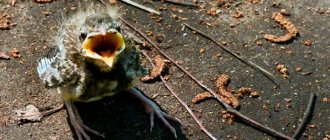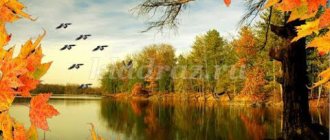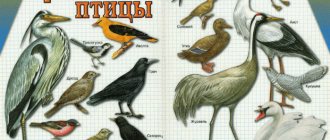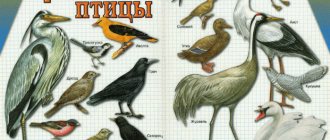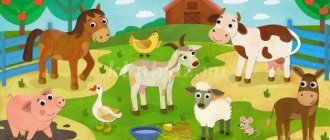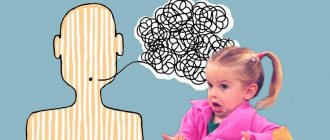Planning a thematic week “Birds of Migratory”
When planning the theme of the week “Birds of Migratory” in the preparatory group, the goal is to conduct daily lessons on one topic. Classes are held in a variety of formats, which helps preschoolers maintain interest in the topic throughout the week.
Children learning about birds is good for their overall development
Target
The purpose of the thematic week “Birds of Migratory” is:
- preschoolers gain new knowledge about animals;
- systematization of existing ones;
- the formation of a sustainable interest in the nature of the native land;
- ability to distinguish between different species;
- developing an understanding of the importance of animals in nature.
Lexical topic
The lexical topic “Migratory Birds” pursues the following goals:
- expand children's vocabulary;
- repeat words already familiar to children;
- formulate sentences correctly when composing a story.
Note! To achieve these goals, the teacher gives children tasks from the vocabulary section “Add!” The teacher reads short poems about migratory birds in which the last word is missing. Kids must fill in the missing words in the rhyme.
Thematic vocabulary is replenished with the following words:
- rook;
- swift;
- martin;
- crane;
- stork;
- wagtail;
- cuckoo;
- starling;
- heron;
- swans;
- lark;
- goose;
- fluff;
- feathers;
- wedge;
- flight;
- birdhouse;
- nest;
- insects;
- insect larvae;
- seeds;
- songbirds;
- twist;
- bring out;
- hatch;
- eggs;
- feed;
- peck;
- fly away;
- spring;
- spend the winter.
Book reading is required
Final event
It is recommended that the final event in the preparatory group be held in the form of a quiz. The group is divided into two or more teams with a captain. Each receives assignments on the topic “Migratory Birds”. Each task is assessed using a point system and the winner is determined based on the results.
Mini project
One week is given to prepare the mini-project (step-by-step preparation method). Children prepare it together with their parents at home. Each pupil and parent receives the name of a migratory bird on which he must collect information:
- Photo on removable media to display on a media board using a projector.
- Description of appearance.
- Habitat.
- Time to return to Russia and fly to winter quarters.
- Nutritional features.
Sequence of stages of implementation of problem-based learning technology
After preparing the project, each child defends it in front of the group. This final lesson gives preschoolers the opportunity not only to prepare information on their own, but also gives them experience in public speaking and helps overcome shyness and fear of an audience.
Interesting! The senior group can also participate in the mini-project.
Migratory birds
Nabytnova Alla Vasilievna teacher of State Budgetary Educational Institution No. 85 “Bee” Saint Petersburg
MIGRATION BIRDS summary of an integrated lesson in the preparatory group
Target:
Creating conditions for the formation and consolidation of preschool children’s knowledge about migratory birds and their characteristics.
Tasks:
- Continue to introduce children to migratory birds. Find out why they fly away, and which birds fly away first.
- Identify the structural features of different types of birds (beak, paws)
- To develop the ability to draw conclusions during experimental activities.
- Activate the ability to use nouns, verbs, and adjectives in speech.
- Develop word formation skills.
Advertising message
Preliminary work:
- Conversation about migratory birds
- Looking at illustrations
- Reading stories and poems
- Bird watching
- Outdoor and didactic games
Equipment: presentation with slides, demonstration pictures “Migratory Birds”, sound recording “Voices of Birds”, ball, game cube, jar of fat, basin of water.
Greetings.
Good morning, we are glad to see you. Let everything that concerns us be good! Let's hold hands together And we will smile at the guests!
Progress of the lesson.
Organizing time.
To the teacher : I want to read you one very interesting poem by Alexander Izmailov, “Birds Rise to Wing”
The birds took to their wings and began to shout in the gloomy sky To a distant land, where it was warm, They flew in a long flock. “It’s getting cold,” the birds say with a cry. -We're not flying forever. -We'll be back, we promise. - Goodbye, dear land: - We're flying away! Let's fly away! Behind the veil of heaven, birds melt in the gray sky.
Educator: What do you guys think, what time of year does the author describe? Where do the birds fly? Why do you think so? (prove)
Children: About autumn, birds fly south (to warm countries)
Educator: Correct! I suggest you head into the autumn forest and say goodbye to the birds. (slide “Autumn Forest”)
- Conversation.
Educator: Guys, look around, what a beauty it is. What is shown on the screen? Answers
Educator: What time of year? What signs of autumn do you know?
Children: Children's answers.
Educator: Tell me, why do birds fly away in the fall?
Children: They answer.
Educator. Right. And the most important reason is that they have nothing to eat.
Educator. Does anyone know which birds fly away first?
Children: Children's answers.
Educator : Well done, such birds are called insectivores. Their beak is straight, elongated or pointed to make it easier to catch insects. Let's take a look at these birds. (Slide 2. Wagtail, swallow, lark, thrush, cuckoo, nightingale)
Then the birds set off, feeding on plant seeds and fruits. They are called granivores. Let's see who it is. (Slide 3. Chaffinch, siskin, oatmeal)
Let's think about why they fly away second?
Children: the harvest has been harvested. The berries and seeds were covered with the first snow.
Educator: Waterfowl are the last to leave us. Name what waterfowl you know. (On screen: goose, duck, swan).
Children: Answers.
Educator: What is the main feature in the body structure of waterfowl?
Children: Waterfowl have webbed feet. To swim faster.
Educator : Well done. How much do you know? Let's relax with you.
Physical education moment. In the morning the gander stood up on his paws
In the morning the gander stood up on his paws, (Stretched, arms up - inhale and exhale.) Prepared for exercise. (Jerks of arms in front of the chest) Turned left, right, (Turns left and right) Did the squat correctly, (Squats.) Cleaned the fluff with the beak, (Tilts the head left and right) Quickly into the water - splash! (Sit down.)
Educator: Well done. Guys, why do waterfowl get away with it?
Children: Answers. The feathers of waterfowl are covered with fat.
Experience.
Let's check this with you and conduct an experiment with water and fat. (the teacher smears the duck with fat, puts it in the water for a few seconds, then takes it out and the children draw conclusions).
Educator: What happened? How does water drain from your hands? It turned into droplet balls that rolled off your hands. The same thing happens with water on the feathers of waterfowl. Bird feathers are covered with a thin layer of fat, so water drains easily.
Educator : (Slide: forest). Guys, have you noticed that you can’t see or hear any birds in the forest? Maybe something happened? Let's sit quietly. It seems that someone is coming towards us.
An old forest man appears on the screen.
Lesovichok: Hello, guys! Oh, you know what trouble we have in the forest! Baba Yaga bewitched all the birds. She said that if there are brave souls and smart people, she will spell the birds back. But where can I find such people in the forest?
Educator : Guys, what should we do? Shall we help? Don’t be sad, Old Forest Man, our guys will be happy to help you disenchant the birds.
Lesovichok : That's great! Baba Yaga left the first task to be completed.
Word game "Count and name"
Rules of the game: the teacher hands out pictures of migratory birds to the children, asks them to look at them and name them. Then the children are asked to take turns throwing a cube with numbers written on the sides and make up sentences (following the example) using the bird and the number that appears on the cube. For example, “I have two storks”, “I have five rooks”. We find an envelope with trees.
Breathing exercises: “Feather”
Educator: Guys, look, the birds dropped their feathers. We need to put these feathers in the nest. Let's put a feather on our palm. Let's take a deep breath through our nose and blow the feather from our palm, exhaling the air completely, carefully so that the feather falls into the nest. (We find the envelope with the second task).
Educator: Let's read the second task.
Exercise “Say in one word”
The stork has long legs, what is it like? ... (long-legged). The stork has a long beak, it... (long-beaked). The swallow has a long tail, it ... (long-tailed). The swallow loves warmth, she... (heat-loving). The swallow has sharp wings, it... (sharp-winged). The nightingale has a ringing voice, he... (clear-voiced). (We find a cloud, a lake and the sun) and an envelope under No. 3.
Educator: Guys, how many tasks have we completed already? What a great fellow you are. Reading the third task?
Game "Birds are mixed up"
Baba Yaga mixed up all the birds. We need to figure out which birds should
fly away first.
Pictures with birds, plates with painted insects, grains, and a lake. Children look at the birds, highlight their characteristic features and place them on the appropriate plates.
Baba Yaga not only mixed up the birds, she also scattered words with the names of the birds. Let's help collect!
Game "The Word Scattered".
The word scattered like seeds in a garden bed. Make up words Help guys. (Find birds)
Lesovichok: Well done!! There is one last task left. Fourth. Baba Yaga stole fragments from the painting. We need to help restore it and repaint it. Can you handle it?
Children: Yes.
Educator: In order for us to do everything carefully, we need to stretch our fingers .
Finger gymnastics.
Flight.
One, two, three The nightingales fly away. And behind them two rooks fly away screaming. We overtook three starlings. We waved goodbye, We'll be back. We promise!
Educator: Well, we stretched our fingers. Now you can begin the last task.
They do the work, apply glue to the fragments of the picture and glue them on. Afterwards, towards the end of the work, an audio recording of “Birdsong” sounds
Lesovichok: Thank you very much guys for your help! The birds will now fly away for the winter. And for your help, the birds gave you a treat. Goodbye!
Lesson reflection.
Educator: What birds did we talk about? What new have you learned about migratory birds? What tasks did you perform? What did you like?
Long-term event planning table
The long-term planning table greatly helps the teacher in preparing for classes. The plan helps distribute information over the calendar year, maintain consistency in its presentation, and effectively carry out preparatory activities.
GCD on the topic “Migratory birds”
Topic: “Migratory birds.” Tasks:
- introduce children to migratory birds;
- explain the difference from non-migratory ones;
- teach to distinguish them by appearance;
- replenish your vocabulary.
The lesson is conducted in the form of conversation and dialogue. Demonstration material is used in the form of images of birds, as well as a documentary film.
Modeling classes
Children attending the preparatory group (6-7 years old) engage in modeling classes with great enthusiasm. Modeling develops fine motor skills and helps with speech development. The most suitable modeling material for children of this age is plasticine, but you can also use salt dough, clay and other materials. Theme of the lesson: “Bird”. Goal: development of hand motor skills, gaining new knowledge about tits. Equipment:
- tables;
- plasticine;
- stacks;
- plastic napkins;
- tit images.
Modeling birds helps in their study
Progress of the lesson:
- “Guys, today we have a modeling lesson. The task will be very interesting!
- “Do you know such a bird as a tit? Some people know, some don't. It is quite bright for our country. And this makes it more noticeable in winter, against the backdrop of snow. This bird is not migratory; it winters in Russia.”
- “Look at the pictures: the tit has a very interesting color. She has a blue-black head, a black belly, beak and paws, a yellow chest, a yellow-green back, dark wings and a tail.”
- “Figure out how you want to portray this bird, take plasticine and mold it.”
- “Come up with a name for her, and at the end of the lesson, share with each other what you came up with.”
Also interesting will be the modeling of “Bird” in the older group.
Application “Birds” in the preparatory group
Topic: “Parrot birds.” Goal: to give knowledge about parrots, to teach the technique of torn paper. Equipment:
- tables;
- colored paper;
- scissors;
- white cardboard for the base;
- glue stick;
- simple pencils;
- erasers;
- images of parrots;
- sample.
Drawing lesson in the senior group of a preschool educational institution on the topic “Flowers for Mom”
Progress of the lesson:
- “Children, we recently became acquainted with migratory birds, and now let’s talk about parrots.”
- “Do you know what they look like? They come in different sizes, but what they have in common is that they are all very bright. They live in warm countries, where there is a lot of light and warmth. They feed on seeds and fruits.”
- “You will need to make an applique, depicting a parrot. You cut out body parts from paper, but the bright, long tail will need to be made using the “torn paper” technique. You tear off thin strips of colored paper and glue them on to represent tail feathers.”
Finger gymnastics
Finger gymnastics “Birds of Migratory” (senior group, middle and preparatory) directly affects the development of speech according to the Federal State Educational Standard, so it is useful not only for children with speech disorders, but also for healthy preschoolers. Both younger and older ages enjoy doing it.
Finger gymnastics develops motor skills
Children first spread their fingers. Each finger is a migratory bird. They begin to bend from the thumb of the left hand. Bend the thumb of the left hand - this is a hiding starling, the index finger is a swallow, the middle finger is a heron, the ring finger is a goose, the little finger is a swift. Now on the right hand. The thumb is a cuckoo, the index finger is a crane, the middle finger is a rook, the ring finger is a stork, the little finger is a wagtail. Suddenly open all your fingers - all the birds fly away. The topic “Migratory Birds” will interest kids and help them learn about birds both in their native land and those living in other regions.
